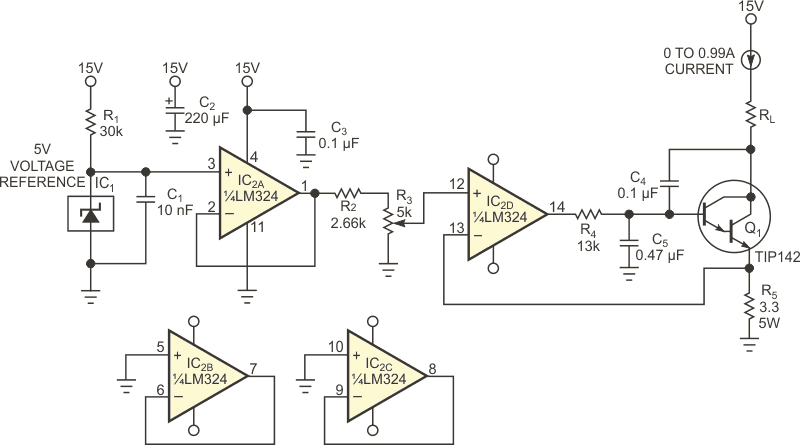Analog circuits for long-term testing of passive components, such as 0.1%-tolerant resistors or high-intensity white LEDs, often require a constant current. Using two op amps and a voltage reference, you can develop a circuit that provides a constant-current sink with a variable setting of 0 mA to 0.99 A. The circuit in Figure 1 sinks a stable current through the load. The load current is insensitive to power-supply-voltage variations. IC1 is a voltage reference that gives a stable 5 V dc. It requires 500 µA of current from the power supply. IC2 is a LM324 quad op-amp. Voltage follower IC2A buffers the reference voltage from the rest of the circuit, which increases stability.
 |
|
| Figure 1. | A voltage reference and two op amps provide a stable voltage to R5, which provides a stable load current. |
Resistor R2 and potentiometer R3 form a variable voltage divider that reduces the 5 V reference voltage to a value between 0 and 3.26 V. Unity-gain amplifier IC2D drives the base of Q1, a Darlington power transistor that has a current gain of 750, through R4. R4 and C5 form a lowpass filter that prevents oscillation. You can drive Q1 with a small base current. C4 connects between the collector and the base of Q1, adding further stability.
Operating as an emitter follower, Q1 can drive an active or a passive load, such as a resistor or a high-brightness LED. Q1’s emitter connects to R5, a 3.3 Ω, 5 W grounded power resistor. The voltage at IC2D’s Pin 14 sets the voltage across R5, which fixes Q1’s emitter current. Because of Q1’s high gain, the current in the load is effectively Q1’s emitter current.
